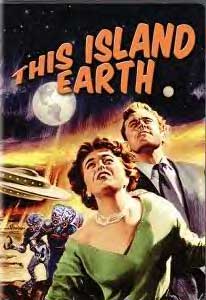 THIS
ISLAND EARTH (1955)
THIS
ISLAND EARTH (1955)Director: Joseph Newman
Universal
 THIS
ISLAND EARTH (1955)
THIS
ISLAND EARTH (1955)The fabulous
1950s provided us with the golden age of science fiction movies, with more than
enough alien invasions to scare the bejesus out of theater patrons of the era.
Most sci-fi opuses were lensed in black & white to keep the budgets low,
but others were shot in color (WHEN WORLDS COLLIDE, WAR OF THE WORLDS, INVADERS
FROM MARS, FORBIDDEN PLANET to name a few) and presented viewers with something
more of a spectacle to behold. By this time, Universal Studios had traded in
the Frankenstein boots and Dracula cloaks for a new, trendier series of creature
features, and 1955’s THIS ISLAND EARTH was one of their more ambitious
productions, shot in Technicolor and laced with innovative, dazzling special
effects. 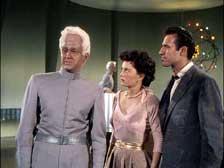
Nuclear scientist Dr. Cal Meachem (Rex Reason) receives some advanced electronic parts which he ultimately builds into an Interociter, a television-like monitoring device. Communicating with Exetor (Jeff Morrow), an other-world being with tanned skin, high bumpy forehead and wavy white hair, Meachem is invited to gather with other collected Earth scientists for an undertaking which will help world peace. Curious, he lets himself be taken to Exetor’s Atlanta headquarters, but after conversing with fellow scientist and old flame Dr. Ruth Adams (Faith Domergue), it is learned that the aliens have something else up their sleeves, so a quick getaway is planned. The aliens are able to abduct the escape plane piloted by Cal and Ruth, and they are taken aboard their saucer spacecraft to Metaluna, a war-ridden, dying planet also inhabited by horrible-looking mutant slaves.
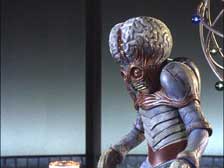 Torn
right from the pages of a Pulp magazine, THIS ISLAND EARTH is an archetypal
space saga, which definitely influenced a number of subsequent films and TV
shows, such as “Star Trek.” The special effects include numerous
explosions, laser beams and soaring spaceships in flight, and despite some clumsy
blue screen projection and obvious painted mattes, they still hold up today
when taken into the perspective that this was made over 50 years ago. The film
also has some impressive set designs, and the use of the Technicolor process
gives the it a true comic book feel. Although the pacing can be sluggish (but
not uninteresting) in parts, the thrilling climax is rewarding, and the film’s
most memorable image – that of the “Metaluna Mutant,” a bug-eyed,
ballooned-cranium, extended clawed veiny menace – has became one of the
most recognizable monsters in movie history. It’s interesting to note
that legendary genre director Jack Arnold (THE CREATURE FROM THE BLACK LAGOON)
helmed parts of the film, but all the credit was given to Joseph Newman.
Torn
right from the pages of a Pulp magazine, THIS ISLAND EARTH is an archetypal
space saga, which definitely influenced a number of subsequent films and TV
shows, such as “Star Trek.” The special effects include numerous
explosions, laser beams and soaring spaceships in flight, and despite some clumsy
blue screen projection and obvious painted mattes, they still hold up today
when taken into the perspective that this was made over 50 years ago. The film
also has some impressive set designs, and the use of the Technicolor process
gives the it a true comic book feel. Although the pacing can be sluggish (but
not uninteresting) in parts, the thrilling climax is rewarding, and the film’s
most memorable image – that of the “Metaluna Mutant,” a bug-eyed,
ballooned-cranium, extended clawed veiny menace – has became one of the
most recognizable monsters in movie history. It’s interesting to note
that legendary genre director Jack Arnold (THE CREATURE FROM THE BLACK LAGOON)
helmed parts of the film, but all the credit was given to Joseph Newman.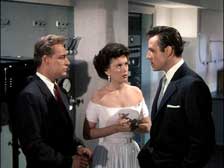
Although some have criticized the leads’ performances, Reason is solid, believable hero and Domergue deserves her acknowledged “scream queen” acclaim. Morrow brings a sympathetic, humane side to his alien character, as all his fellow humanoids (including the often stiff Lance Fuller, later to appear in a handful of AIP drive-in fillers) are seemingly emotionless and ruthless. Reason and Morrow would be reunited a year later in THE CREATURE WALKS AMONG US, while Domergue and Morrow much later co-starred in the 1971 schlock cheapie LEGACY OF BLOOD. Russell Johnson also appears as a fellow friendly human scientist. Johnson was a popular supporting actor in 1950s sci-fi flicks (IT CAME FROM OUTER SPACE, ATTACK OF THE CRAB MONSTERS, SPACE CHILDREN) and of course became immortalized as “The Professor” on TV's “Gilligan’s Island.”
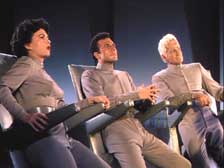 Previously
released (and long out of print) on DVD from Image Entertainment, Universal
has re-issued the film as an inexpensive single disc. Presenting it in a full
frame open matte transfer (many resources dictate that the film was intended
to be matted at 2:00.1), the transfer is an improvement over the previous Image
issue. Although the image has speckling and other blemishes, as well as a few
splashes of grain, the transfer is quite sharp throughout and picture detail
is well defined. Colors are also bold and distinct, with skintones looking natural,
and on a whole looks brighter than the previous release. The mono audio provides
a strong track, and there optional English, Spanish and French subtitles. The
only extra is the original theatrical trailer. (George
R. Reis)
Previously
released (and long out of print) on DVD from Image Entertainment, Universal
has re-issued the film as an inexpensive single disc. Presenting it in a full
frame open matte transfer (many resources dictate that the film was intended
to be matted at 2:00.1), the transfer is an improvement over the previous Image
issue. Although the image has speckling and other blemishes, as well as a few
splashes of grain, the transfer is quite sharp throughout and picture detail
is well defined. Colors are also bold and distinct, with skintones looking natural,
and on a whole looks brighter than the previous release. The mono audio provides
a strong track, and there optional English, Spanish and French subtitles. The
only extra is the original theatrical trailer. (George
R. Reis)